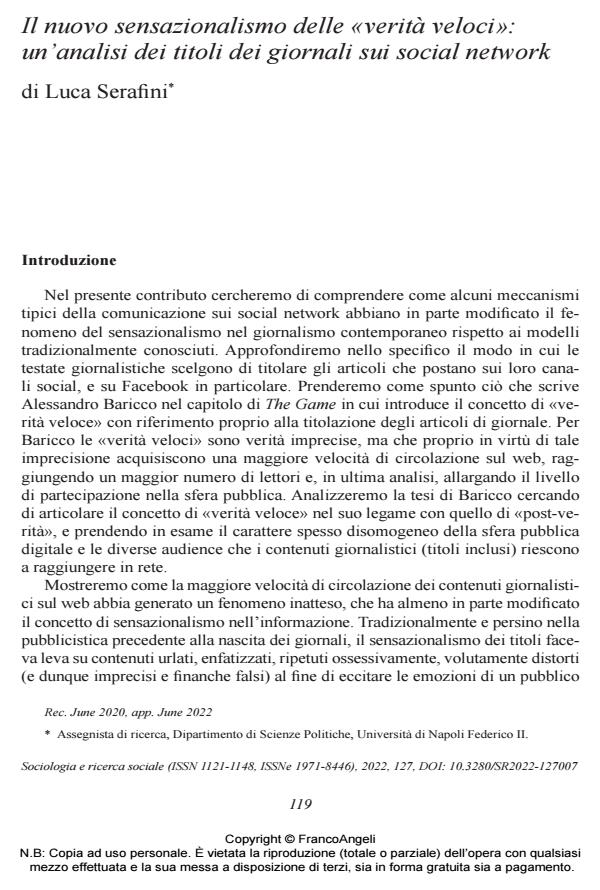The new sensationalism of «quick truths»: an analysis of newspa- per headlines on social networking sites
Journal title SOCIOLOGIA E RICERCA SOCIALE
Author/s Luca Serafini
Publishing Year 2022 Issue 2022/127 Language Italian
Pages 19 P. 119-137 File size 214 KB
DOI 10.3280/SR2022-127007
DOI is like a bar code for intellectual property: to have more infomation
click here
Below, you can see the article first page
If you want to buy this article in PDF format, you can do it, following the instructions to buy download credits

FrancoAngeli is member of Publishers International Linking Association, Inc (PILA), a not-for-profit association which run the CrossRef service enabling links to and from online scholarly content.
This paper shows how some typical communication mechanisms on social networking sites have reconfigured the phenomenon of sensationalism in journal- istic information. Analyzing newspaper headlines on social platforms, it is clear that a «minimalist sensationalism» is emerging, which is connected to a specific articulation of the concept of post-truth, that of «quick truth». The strengths and weaknesses of this new sensationalism are then examined: sometimes, it facilitates users’ access to information of public interest. In other cases, however, the intrinsic limits of online communication and the digital public sphere (often artic- ulated based on homophilic networks) lead such imprecise truths to fuel misinfor- mation and deprive users of their reflective capacities.
- J. Baudrillard (1972), Pour une critique de l’économie politique du signe, Paris, Gallimard; tr. it., Per una critica dell’economia politica del segno, Milano, Mazzotta, 1974.
- J. Baudrillard (1976), L’échange symbolique et la mort, Paris, Gallimard; tr. it., Lo scambio simbolico e la morte, Milano, Feltrinelli, 1979.
- E. Arielli, P. Bottazzini (2018), Idee virali, Bologna, il Mulino.
- A. Baricco (2018), The Game, Torino, Einaudi.
- E. Campo (2019), L’attenzione nella new economy. Un’analisi critica, in E. Profumi a A.M. Iacono (a c. di), Ripensare la politica. Immagini del possibile e dell’alterità, Pisa, Ets.
- E. Campo (2020), La testa altrove. L’attenzione e la sua crisi nella società digitale, Roma, Donzelli.
- N. Carr (2010), The Shallows: What the Internet is doing to Our Brains, New York, W.W. Nor- ton; tr. it., Internet ci rende stupidi?, Milano, Raffaello Cortina, 2011.
- M. Castells (2009), Comunicación y Poder, Madrid, Alianza Editorial; tr. it., Comunicazione e potere, Milano, Bocconi Università, 2009.
- A. Dal Lago (2017), Populismo digitale, Milano, Raffaello Cortina.
- L. De Biase (2011), Cambiare pagina, Milano, Rizzoli.
- C. Dewey (2016), «6 in 10 of you will share this link without reading it, a new depressing study says», Washington Post, -- https://www.washingtonpost.com/news/the-intersect/ wp/2016/06/16/six-in-10-of-you-will-share-this-link-without-reading-it-according-to-a- new-and-depressing-study/.
- G. Di Caterino, G. Veltri (2017), Fuori dalla bolla, Milano-Udine, Mimesis.
- J. Falkinger (2008), «Limited Attention as a Scarce Resource in Information-Rich Economies», The Economic Journal, 118, 532, pp. 1596-620,
- M. Ferraris (2017), Postverità e altri enigmi, Bologna, il Mulino.
- J. Habermas (1962), Strukturwandel der Öffentlichkeit. Untersuchungen zu einer Kategorie der bürgerlichen Gesellschaft, Neuwied am Rhein, Luchterhand; tr. it., Storia e critica dell’opinione pubblica, Bari, Laterza, 1971.
- M. Infelise (2002), Prima dei giornali. Alle origini della pubblica informazione, Roma-Bari, Laterza.
- M. Infelise (2007), From merchants’ letters to handwritten political avvisi: notes on the origins of public information, in F. Bethencourt, F. Egmond (eds.), Cultural exchange in early mo- dern Europe, Cambridge, Cambridge University Press, vol. III.
- P. Jones (2007), «Beyond the Semantic “Big Bang”. Cultural Sociology and an Aesthetic Public Sphere», Cultural Sociology, 1, 1, pp. 73-95, DOI: 10.1177/1749975507073921
- D. Kahneman (2011), Thinking, Fast and Slow, New York, Straus and Giroux; tr. it., Pensieri lenti e veloci, Milano, Mondadori, 2012.
- R. Keyes (2004), The Post-Truth Era: Dishonesty and Deception in Contemporary Life, New York, St. Martin’s Press.
- M. Livolsi (2013), La partecipazione solitaria, in R. Bartoletti, F. Faccioli (a c. di), Comunica- zione e civic engagement, Milano, FrancoAngeli.
- A. Lorusso (2018), Postverità, Roma-Bari, Laterza.
- M. Maffesoli (1988), Le temps des tribus. Le déclin de l’individualisme dans les sociétés post- modernes, Méridiens-Klincksieck, Paris; tr. it., Il tempo delle tribù. Il declino dell’indivi- dualismo nelle società contemporanee, Milano, Guerini, 2004.
- F. Mello (2019), Il lato oscuro di Facebook, Reggio Emilia, Imprimatur.
- A. Natale (2008), Gli specchi della paura, Roma, Carocci.
- S. Nobile (2018), «Il prezzo dell’impermanenza. Note critiche su The Game di Alessandro Baricco», Comunicazionepuntodoc, 20, pp. 161-5.
- E. Pariser (2011), The Filter Bubble: What the Internet is Hiding from You, New York, Penguin
- Press; tr. it., Il filtro: quello che internet ci nasconde, Milano, Il Saggiatore, 2012.
- W. Quattrociocchi, A. Vicini (2016), Misinformation. Guida alla società dell’informazione e della credulità, Milano, FrancoAngeli.
- L. Ricci (2013), Paraletteratura. Lingua e stile dei generi di consumo, Roma, Carocci.
- C. Rocca (2019), Chiudete Internet, Venezia, Marsilio.
- M. Sassatelli (2012), Festivals, museums, exhibitions. Aesthetic cosmopolitanism in the cultu- ral public sphere, in G. Delanty (ed.), Routledge Handbook of Cosmopolitanism Studies, London-New York, Routledge.
- H.A. Simon (1971), Desinging organizations for an information-rich world, in M. Greenberger (ed.), Computers, communication and the public interest, Baltimore, John Hopkins Press.
- C.R. Sunstein (2008), Why groups go to extremes, Washington DC, Aei Press.
- C.R. Sunstein (2017), #Republic. Divided Democracy in the Age of Social Media, Princeton, Princeton University Press; tr. it., #republic. La democrazia nell’epoca dei social media, Bologna, il Mulino, 2017.
- T. Terranova (2012), «Attention, Economy and the Brain», Culture Machine, 13.
- A. Toffler (1970), Future Shock, New York, Bantam Books; tr. it., Lo choc del futuro, Milano, Rizzoli, 1971.
- P. Virilio (1989), Esthétique de la disparition, Paris, Galilée; tr. it., Estetica della sparizione, Napoli, Liguori, 1992.
- C. Wardle, H. Derakhshan (2017), Information disorder: Toward an Interdisciplinary fra- mework for research and policy making, Strasbourg, Council of Europe
Luca Serafini, Il nuovo sensazionalismo delle «verità veloci»: un’analisi dei titoli dei giornali sui social network in "SOCIOLOGIA E RICERCA SOCIALE " 127/2022, pp 119-137, DOI: 10.3280/SR2022-127007